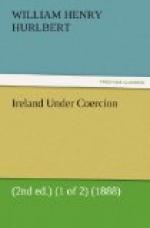Kilkenny boasts that its streets are paved with marble. It is in fact limestone, but none the worse for that. The snow did not improve them. So without going on a pilgrimage to the Kilkenny College, at which Swift, Congreve, and Farquhar,—an odd concatenation of celebrities—were more or less educated, we made our way to the Imperial Hotel for luncheon. The waiter was a delightful Celt. Upon my asking him whether the house could furnish anything distantly resembling good Irish whisky, he produced a bottle of alleged Scotch whisky, which he put upon the table with a decisive air, exclaiming, “And this, yer honour, is the most excellent whisky in the whole world, or I’m not an Irishman!”
Urged by the cold we tempered it with hot water and tasted it. It shut us up at once to believe the waiter a Calmuck or a Portuguese—anything, in short, but an Irishman. It is an extraordinary fact that, so far, the whisky I have found at Irish hotels has been uniformly quite execrable. I am almost tempted to think that the priests sequestrate all the good whisky in order to discourage the public abuse of it, for the “wine of the country” which they offer one is as uniformly excellent.
Kilkenny ought to be and long was a prosperous town. In 1702, the second Duke of Ormonde made grants (at almost nominal ground-rents) of the ground upon which a large portion of the city of Kilkenny was then standing, or upon which houses have since been built.
These grants have passed from hand to hand, and form the “root of title” of very many owners of house property in Kilkenny. The city is the centre of an extensive agricultural region, famous, according to an ancient ditty, for “fire without smoke, air without fog, water without mud, and land without bog”; but of late it has been undeniably declining. For this there are many reasons. The railways and the parcel-post diminish its importance as a local emporium. The almost complete disappearance of the woollen manufacture, the agricultural depression which has made the banks and wholesale houses “come down” upon the small dealers, and the “agitation,” bankrupting or exiling the local gentry, have all conspired to the same result.




